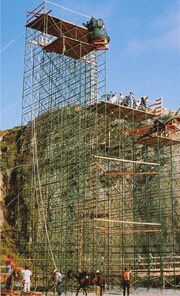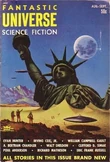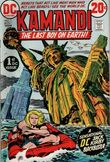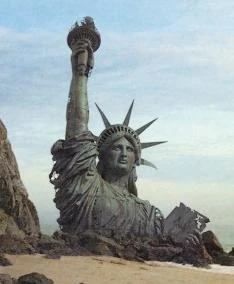
The remains of the Statue of Liberty
The Statue of Liberty was a colossal metal sculpture located on Liberty Island in the middle of the harbor of New York City. The statue was a gift to the United States from the people of France and represented Libertas, the Roman goddess of freedom, bearing a torch and a tablet inscribed with the date of the American Declaration of Independence. The statue was a symbol of freedom and international friendship, a welcoming signal to immigrants arriving from abroad, and one of America's most treasured icons.
Planet of the Apes[]
The statue was one of the few surviving icons of pre-apocalyptic human civilization. However the course of centuries, dramatic geological shifts left the statue halfway buried in the sand.
In 3978, human refugee George Taylor fled from Ape City with his newly acquired mate, Nova. During the course of several days, Taylor believed that he had been living on a strange, alien world. Following the shoreline, he came upon the Statue's ruins and realized that he was on Earth. Worse, he deduced that the humans of his own era must have waged a global war, which paved the way for a dystopian future where humans became subservient to evolved apes.
Speculation[]
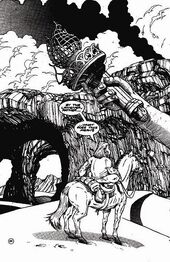
Young Zaius learns the truth in Sins of the Father
It could be inferred that Dr. Zaius knew of the existence of the Statue of Liberty. It is clear that he was aware of mankind's past, and to some extent, possessed knowledge of humanity's downfall. When Taylor indicated his plan to "find his destiny", Zaius cryptically responded with, "Do not look for it, Taylor. You may not like what you find." In all likelihood, Zaius may have been referencing the Forbidden Zone, but it is just possible that he was speaking of the Statue itself. A large copper statue bearing a human face would have been an artefact of disturbing and heretical significance to one such as Dr. Zaius. Rod Serling, in his early script treatments for the movie, specified that Zaius should have suspicions about humanity's civilized past, "but it must be only an inkling", and that his realization of the truth should not occur until after the discoveries at Cornelius' archaeological site. In contrast, Malibu Graphics' Planet of the Apes: Sins of the Father depicted the Statue of Liberty revealed to a young Zaius by his father Dr. Augustus, Minister of Science.
Behind The Scenes[]
It was during the early script revisions that the idea for the famous ending to Planet of the Apes was devised. Producer Arthur P. Jacobs recalled, "We were trying to make the audience believe it was another planet, which differs from Boulle's novel in which it WAS another planet. I thought that was rather predictable when we were doing the first screenplay. It's funny, I was having lunch with Blake Edwards, who at one point was going to direct it, at the Yugo Kosherarna Delicatessen in Burbank, across the street from Warner Brothers. I said to him at the time. 'It doesn't work, it's too predictable.' Then I said, 'What if he was on the earth the whole time and doesn't know it, and the audience doesn't know it.' Blake said, 'That's terrific. Let's get a hold of Rod.' As we walked out, after paying for the two ham sandwiches, we looked up, and there's this big Statue of Liberty on the wall of the delicatessen. We both looked at each other and said, 'Rosebud' (the key to the plot of 'Citizen Kane'). If we never had lunch in that delicatessen, I doubt that we would have had the Statue of Liberty as the end of the picture. I sent the finished script to Boulle, and he wrote back, saying he thought it was more inventive than his own ending, and wished that he had thought of it when he wrote the book." [1]
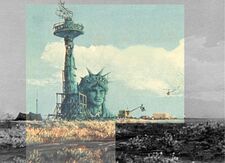
Don Peters concept artwork
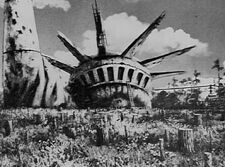
Production art
Blake Edwards himself claimed that he came up with the Statue of Liberty ending with former Disney artist Don Peters, adding "As I recall it was pretty much Don". Don Peters, for his part, claimed that it was his idea alone, because he first introduced the ruined Statue of Liberty scenes to the Apes project when he did the preliminary sketches for Arthur P. Jacobs when the film was in development at Warner Bros. [2] However, the twist ending has also been attributed to Rod Serling, whose experience writing for Twilight Zone gives his claim more credence. Mort Abrahams, who as associate producer was very involved in script revisions, said succinctly "That was Rod's ending".[3] Serling's numerous script revisions through 1964 and 1965 show an evolving concept, from the movie being set on an alien planet (as in the book), to the discovery of Earth artifacts in a bomb shelter, to the sight of the famous statue. When asked about the ending himself, Serling said (in 1972), "The book's ending is what I wanted to use in the film, as much as I loved the idea of the Statue of Liberty. I always believed that was my idea." But when asked if the ending was a combination of four or five people thinking exactly the same thing at about the same time, he replied, "That's very possible. Visually, it's an exciting idea because a fragment can be taken from it, and still withhold what it is. That's the beauty of the Statue of Liberty."[1] Speaking to Marvel Comics two years later, Serling shared the credit, saying it was "In collaboration with Jacobs. Yes, it was a wild cinematic scene."[4] In stark contrast to Jacobs' above assertion, Boulle maintained: "I disliked somewhat, the ending that was used - the Statue of Liberty - which the critics seemed to like, but personally, I prefer my own. Since they decided to make the film, they picked this ending. They had that final scene in mind from the first day." [1] J.W. Rinzler's research points to Serling having set the movie on Earth and credits Peters as the sole originator of the Statue of Liberty concept; counter-claims are attributed to publicity boasts and clouded memories.[5]
Notes[]
- There are two scenes where we see the Statue of Liberty, each scene having been done a different way.
- The first is shot from above, down through the crown of the edifice, showing the hand holding the torch; art director William Creber built a half-scale model replica of the top of the head and the torch from cardboard and paper maché, expertly positioned in the frame to look real. This shot looking down at Taylor required a 70-foot high scaffold tower to be constructed. At 66 years of age, director of photography Leon Shamroy refused to climb the structure, while the assistant director had a phobia of heights. Instead, director Franklin J. Schaffner and William Creber lensed the perspective shot, filmed on a secluded cove named Westward Beach situated between Zuma Beach and Point Dume, California.
- The second scene was a matte shot—a very detailed painting done on glass by Emil Kosa Jr, with transparent areas through which the live action could appear. The extra-smooth surface permits the artist to be very detailed, without the surface grain of canvas or paper.[6][7][8]
- Footage of the Statue of Liberty scene from Planet of the Apes was reused in the opening sequence of Beneath the Planet of the Apes.
- The Statue of Liberty was featured on the cover art for the Planet of the Apes DVD included in the "Planet of the Apes: The Evolution" collection (2001).
- The iconic Statue of Liberty scene has been referred to in many used and unused Planet of the Apes movie scripts:
- In Pierre Boulle's 1968 sequel to the original movie, titled Planet of the Men, Taylor leads the primitive humans in rebuilding their ancient culture, including restoring the Statue of Liberty to its former glory.
- Adam Rifkin's 1988 reboot attempt, Return to the Planet of the Apes (a direct sequel to the original movie, ignoring the other four sequels), ended with Taylor's son and his girlfriend sitting by the Statue of Liberty pondering a peaceful future for their world.
- Terry Hayes' Return of the Apes (1995) ends with hero Will Robinson—thrown back to pre-historic times—building a sculpture of the head and crown of the Statue of Liberty out of iron and rock and sand on a rocky cliff above a golden beach, “to make sure we never forget where we came from.”
- The action in Sam Hamm's Planet of the Apes screenplay (1995) takes place on an alien planet ruled by apes. When Dr. Alexander Troy returns to Earth in 2073 after a long absence, his ship flies over the New York harbor and past the Statue of Liberty, but "her once-proud porcelain features have been crudely chiselled into the grotesque likeness of a great grinning ape."
- The statue also appeared in three Planet of the Apes computer games.
- Fox/Atari VCS Game (1983/2003)
- UbiSoft/Fox PC Game (2001)
- UbiSoft/Fox GameBoy (2001)
- Tim Burton's Planet of the Apes (2001) did not feature the statue; however, the ancient wreckage of the spaceship Oberon, with its arc of spikes, was intended to recall the statue's spiked crown. The function of the "American symbol that makes the protagonist realize that Earth is the planet of the Apes" is passed to the Lincoln Memorial (which has General Thade's face on it) which is very close to what Sam Hamm's 1995 Planet of the Apes screenplay described.
- In the 2011 film Rise of the Planet of the Apes Rise of the Planet of the Apes, Caesar is seen in his attic assembling a toy model of the statue.
Trivia[]
- The significance of the Statue of Liberty in American culture has made it a popular reference in science fiction imagery. It was featured on two Alex Schomburg magazine covers from 1953 and 1964.[9] Gold Key Comics' post-apocalyptic Mighty Samson showed a ruined Statue of Liberty on a 1965 cover;[10] and as far back as 1887, and many times since, the image of a war-damaged Statue of Liberty was used to stir patriotic instincts in the American public.[11]
- Comic book legend Jack Kirby paid homage to the climactic scene from Planet of the Apes in the first issue of the DC Comics series Kamandi: The Last Boy on Earth (November 1972).
- In the Mel Brooks comedy Spaceballs (1987), Spaceball One/Mega-Maid crash-lands on a beach and takes on the appearance of the Statue of Liberty. Two chimpanzees on horseback witness what is "coming out of her nose" and dread the arrival of the Spaceballs.
Appearances[]
External Links[]
- FAQ page at 'The Last Flight of the Icarus'
- 'The ruined Statue of Liberty' at Gerry Canavan blogspot
- Statue of Liberty article at Wikipedia
References[]
- ↑ 1.0 1.1 1.2 'Cinefantastique Planet of the Apes Issue' (1972) at Hunter's Planet of the Apes Archive
- ↑ The Legend of the Planet of the Apes, by Brian Pendreigh
- ↑ The Planet of the Apes Chronicles by Paul A. Woods (Page 46)
- ↑ 'Marvel Planet of the Apes, UK Issue 12' (1975)
- ↑ The Making of Planet of the Apes, by J.W. Rinzler (2018)
- ↑ SFX on the Planet of the Apes, by James Glenn - 'Planet of the Apes' UK #95 (11 August 1976)
- ↑ Behind the Planet of the Apes
- ↑ Planet of the Apes: 40 Year Evolution, by Lee Pfeiffer & Dave Worrall (June 2008)
- ↑ FAQ page at 'The Last Flight of the Icarus'
- ↑ Apes Comic Oddities - 'Simian Scrolls' #9 (2004)
- ↑ 'The ruined Statue of Liberty' at Gerry Canavan blogspot

